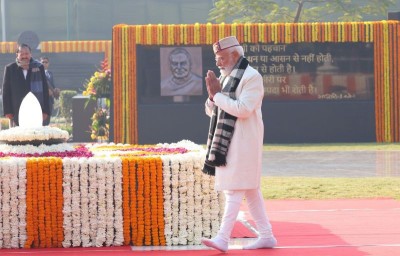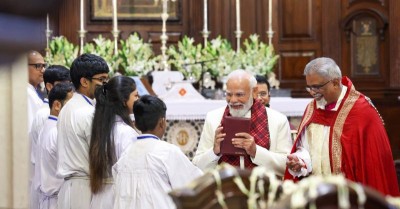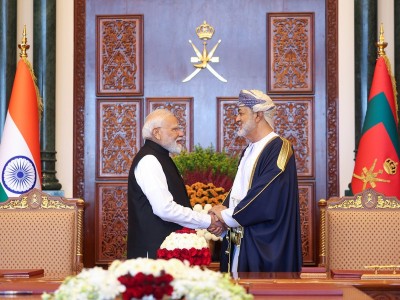
Salvaging Order
On July 1, 2017, Lashkar-e-Toiba (LeT)'s Anantnag 'district commander' Bashir Ahmad Wani aka Bashir Lashkar and one of his associates, identified as Azad Ahmad Malikaka Dada, were killed in an encounter in the Brenti-Batpora area of Anantnag District. The encounter ensued when SFs after receiving information about the presence of terrorists in the area were attacked by the terrorists hiding inside a house. Bashir, according to media reports, figured in a list of 12 'most wanted terrorists' in the state released by the Indian Army on May 30, 2017. Two civilians, including a woman, were also killed during the exchange of fire.
On June 25, 2017, two LeT terrorists were killed in an encounter that broke out between terrorists and SFs in the Delhi Public School building at Pantha Chowk in Srinagar. The terrorists were hiding inside the school building after carrying out an attack on a Central Reserve Police Force (CRPF) vehicle at the gate of the school, killing one trooper and injuring two in the evening of June 24. The slain terrorists were identified as Abu Tala and Abu Hurraira, both Pakistanis. Two AK rifles, one Underbarrel Grenade Launchers (UBGL), two grenades and six AK-magazines were recovered from their possession. At least three Army soldiers were injured during the operation inside the building.
According to partial data compiled by the South Asia Terrorism Portal (SATP), at least 95 terrorists have been killed in the State since the beginning of the current year (data till July 9, 2017). During the corresponding period of the previous year, SFs had eliminated at least 81 terrorists. The number of slain terrorists during the corresponding periods of 2015, 2014, and 2013 stood at 44, 48 and 31 respectively. [Year 2013 has been taken as starting point for analysis because, after recording a continuous decline in overall terrorism-related fatalities since 2002, a reversal in this trend commenced in 2013]. Significantly, total terrorist fatalities through 2013, 2014, and 2015, stood at 100, 110, and 113, respectively, just over the numbers killed in the first six months and a week of the current year.
The number of SF personnel killed in the current year, thus far, stands at 40, as against 30 during the corresponding period of 2016. The number of SF personnel killed during the corresponding periods of 2015, 2014, and 2013 was 22, 16, and 31, respectively. Despite the larger loss of SF lives, the fatalities ratio between SF personnel and terrorists has been maintained at comparable levels: 1:2.3 (2017), 1: 2.7 (2016), 1: 2 (2015), and 1:3 (2014). In the corresponding period of 2013, the kill ratio was at par 1:1.
Meanwhile, at least 30 civilians have already died in the current year, as against five killed during the corresponding period of 2016. The number of civilians killed during the corresponding periods of 2013, 2014, and 2015, were 12, 10, and 12, respectively. Further dissection of the data reveals that, out of a total of 30 civilians killed in the current year, thus far; at least 13 were killed during exchanges of fire between terrorists and SFs. The number of civilians killed in such incidents was one, nil, four, and one, respectively, in the corresponding periods of 2013, 2014, 2015, and 2016. The high number of civilians killed in cross fire in the current year is a disturbing development, and has often resulted from the assembly of violent crowds engaging in stone pelting against SFs, in support of beleaguered terrorists at various locations. SFs are now focusing on a range of measure to secure and segregate encounter sites to prevent public access or supporting action by radicalized crowds.
There have been 168 terrorism-related incidents in 2017 (data till July 2, 2017), as compared to 126 in the corresponding period of 2016, according to a media report. Incidents of explosion and resultant fatalities have increased from 14 and none in 2016 (data till July 9, 2016) to 24 and five respectively in 2017 (till July 9, 2017). Though the number of suicide attacks remained the same - one each in both the years, during corresponding periods, the resultant fatalities in these incidents declined from 10 in 2016 to five in 2017.
These numbers clearly suggest that, though the trends to declining violence have been reversed in the State over the past few years, the current security situation in the State, while disturbing, is far from alarming. Attempts by a section of the media and some 'experts' to create an atmosphere of panic are based on ignorance or deliberate deceit.
There are, in fact, indicators that, with stronger SF action, a measure of stability is being restored, despite some big SF losses in the aftermath of the killing of HM 'commander' Burhan Wani on July 8, 2016. While SFs had imposed a kill ratio of 1:1.48 during the first six months after the killing of Burhan Wani (between July 9, 2016, and January 9, 2017) this ratio improved significantly in the following six months, at 1:2.3.
Crucially, orchestrated street violence - backed by Pakistan-based terrorist formations and covert Pakistani support - subsequent to the Burhan Wani killing, which had created an environment of disorder and panic, is rapidly subsiding. According to reports, there have been 142 'law and order incidents' in 2017 (till June 30). In July 2016 alone, there were 820 such incidents. On December 19, 2016, the then Director General of Police (Law and Order) Shesh Pal Vaid had disclosed that a total of 2,380 'law and order incidents' had been reported during the 'Kashmir unrest', commencing July 8, 2016. Of these, at least 820 incidents were reported in July, declining to 747 in August, 535 in September, 179 in October, 73 in November and just 25 during the first 19 days of December. According to SATP, there were another two incidents of street violence thereafter, in 2016.
Nevertheless, flawed policies and the abject failure of the state in controlling the spiraling violence in the initial stages after the Burhan Wani killing created ample opportunities for inimical forces to broaden radical and extremist mobilization and violence, with a spurt in terrorist recruitment. 88 locals reportedly joined terrorism in 2016, mostly after the killing of Burhan Wani, and another 27 are believed to have already joined terrorist ranks in 2017 (till July 3, 2017).
Governments - both at the state and central level - appear to have started initiating some corrective measures. State Director General of Police Shesh Pal Vaid (who took charge on January 1, 2017) stated on February 14, 2017, that a "course correction" was already underway. Though he refused to divulge any details, asserting that any discussion of the issue would be premature, he admitted, "We are reaching out to the parents and requesting them to convince their children to shun the path of violence. In a few cases, we have achieved success also." Meanwhile, on July 3, 2017, an unnamed Police spokesman disclosed, "As many as 54 youth have been arrested from different Districts of Kashmir over the past few months. The arrests foiled their attempts to join militancy, thereby saving 54 families getting adversely affected by the militancy. "
Further, the Union Ministry of Home Affairs (UMHA) has reportedly come up with a three-fold plan to eradicate terrorism in the State: launch of an offensive on terrorists, keeping tabs on journalists and writers who inflame the situation, and tightening the grip on separatists. According to sources, the Centre may ask Governor N.N. Vohra to directly oversee the combat operations. Chief Minister Mehbooba Mufti, who also holds home portfolio and heads the unified headquarters of security agencies, including the Army, will be kept in the loop only when the agencies take on terrorists in an encounter.
Though SFs have once again managed to contain the consequences of irresponsible politics and administrative failure in Kashmir, threats persists. This tragic cycle has been seen again and again, with SFs establishing dominance and a measure of control at great cost and through tremendous sacrifices, only to see these gains frittered away by political adventurism, incompetence or sheer mischief.
Support Our Journalism
We cannot do without you.. your contribution supports unbiased journalism
IBNS is not driven by any ism- not wokeism, not racism, not skewed secularism, not hyper right-wing or left liberal ideals, nor by any hardline religious beliefs or hyper nationalism. We want to serve you good old objective news, as they are. We do not judge or preach. We let people decide for themselves. We only try to present factual and well-sourced news.







